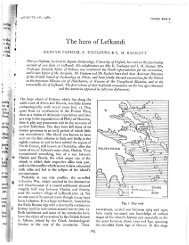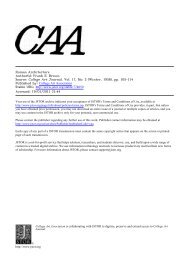September 2007 (PDF) - Classical & Near Eastern Studies ...
September 2007 (PDF) - Classical & Near Eastern Studies ...
September 2007 (PDF) - Classical & Near Eastern Studies ...
You also want an ePaper? Increase the reach of your titles
YUMPU automatically turns print PDFs into web optimized ePapers that Google loves.
appeared (Abingdon), and I was honored to co-edit a Festschrift<br />
for an esteemed colleague - Paul and Divine Impartiality, In Honor of<br />
Jouette Bassler (Sheffield Academic Press). My “A Rhetoric of<br />
Violence: Mere Metaphor of Virtual Reality? 2 Cor. 10:1-6 and<br />
11:1-15” appeared in the volume. I was especially pleased to be an<br />
invited lecturer on Paul and religious violence at the<br />
“International Conference on Religion and Culture” at Payap<br />
University, Chiang Mai, Thailand, and finally the upcoming<br />
Conference, “Sanctified Violence in Ancient Mediterranean<br />
Religions”, Oct. 6-8, UM St. Paul has been all consuming.<br />
Philip Sellew<br />
This year I devoted considerable time to the revisions to our graduate<br />
programs outlined in my DGS report in the last Newsletter.<br />
These reforms seem to be having the desired effect of propelling<br />
students through their degree programs more rapidly while also<br />
focusing their training more usefully and efficiently. In May I<br />
attended a fascinating conference at Harvard on late-antique<br />
Thessaloniki and especially its emergent Christian identity. It was<br />
good to see old friends and colleagues as well as make new contacts<br />
with historians and archaeologists working in Greece.<br />
Current writing projects still involve the Gospel of Thomas, as well<br />
as some intriguing linguistic and rhetorical puzzles in the newly<br />
published Coptic Gospel of Judas.<br />
Ed Schiappa<br />
Edward Schiappa is Professor & Chair of the Communication<br />
<strong>Studies</strong> Department and holds the Frenzel Chair of Liberal Arts.<br />
His work in classical Greek rhetorical theory has been published<br />
in various journals in English, Classics, Philosophy, and<br />
Communication. His books include Protagoras & Logos: A Study in<br />
Greek Philosophy & Rhetoric, Landmark Essays in Greek Rhetoric, and<br />
The Beginnings of Rhetorical Theory in <strong>Classical</strong> Greece. He has<br />
recently completed a co-authored book titled The Disciplining of<br />
Discourse: The Emergence of Terms of Art in Rhetorical Theory in<br />
<strong>Classical</strong> Greece. His most recent classical publication, co-authored<br />
with Jim Hamm, is the introduction to the Blackwell Companion to<br />
Greek Rhetoric.<br />
George Sheets<br />
Two pieces were published this past year: a study of Roman statutory<br />
language and a fairly wide-ranging essay on elements of style<br />
in Catullus. After years of teaching comparative grammar without<br />
an adequate and up-to-date textbook, I have commenced writing<br />
a book that I hope will fill that need. It is tentatively called<br />
Historical-Comparative Grammar of Greek and Latin.<br />
Jeffrey Stackert<br />
This past year was a very exciting and productive one for me. In<br />
addition to teaching two new courses, I completed my book,<br />
Rewriting the Torah: Literary Revision in Deuteronomy and the<br />
Holiness Legislation (Mohr Siebeck), and am pleased to announce<br />
its appearance (August <strong>2007</strong>). I also completed two short articles<br />
on adoption and asylum in the Hebrew Bible and the ancient <strong>Near</strong><br />
East for the Encyclopedia of the Bible and its Reception (deGruyter). I<br />
presented papers at conferences in Washington, DC, St. Paul, MN,<br />
and Vienna, Austria, and gave invited lectures at Yale University,<br />
the University of Minnesota, and the University of Chicago. Best<br />
of all, in February, my wife, Richelle, and I became the proud parents<br />
of a baby boy, George Jeffrey, who has become a constant<br />
source of joy.<br />
Eva von Dassow<br />
This past year, while shepherding my book, State and Society in the<br />
Late Bronze Age, through the editing and proofreading process,<br />
I’ve been occupied with a variety of smaller tasks, from a teacher’s<br />
workshop in Orlando, Florida to the publication of the cuneiform<br />
cone found in a shoebox (together with its newfound mate in<br />
Berlin; see feature on pg. 13). During the coming year I’m on<br />
leave, for the first time ever, thus free to do research – about freedom<br />
in the ancient <strong>Near</strong> East. I’m beginning a new research project<br />
with the goal of ascertaining what concepts of personal, social,<br />
and political rights and freedom were operative in ancient <strong>Near</strong><br />
<strong>Eastern</strong> societies, based on their articulation in legal, epistolary,<br />
and literary texts. For this purpose I have to learn a couple more<br />
dead languages, so I’m off to Germany to study.<br />
3<br />
East view between Murphy Hall (left) and Ford Hall (right).<br />
—photo by Patrick O’Leary







